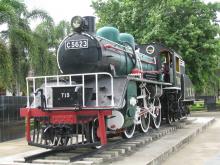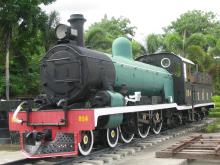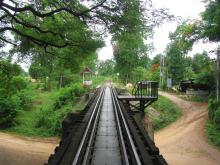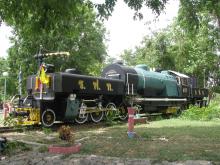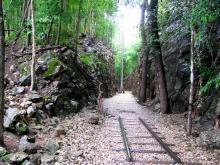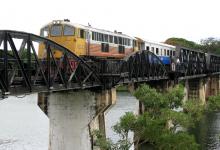In December 1941 the Imperial Japanese Army invaded Thailand from Cambodia and the Gulf of Thailand, in response to which Britain sent out Prince of Wales and Repulse. These were promptly sunk by Japanese aircraft and in a matter of weeks the Japanese had conquered Burma. On 15 February 1942 the British stronghold of Singapore fell and a British force of almost 85,000 men was taken in to captivity. These included Australian, Indian and local troops. Unable to gain command of the sea, the Japanese then decided to build a rail connection through Thailand to Burma and on to India in pursuit of their strategic intent to invade India. To build this railway system they decided to use the POWs for this task. The meter gauge railway line started from Nong Pladuk passing through Kanchanaburi and then crossing the Kwai River to continue along the Kwae Noi River to the Burmese Border. At the same time work started from Burmese border southward from the area around Three Pagodas Pass to meet the line coming north. These routes passed through dense jungle-covered mountains and involved construction of more than 300 bridges and trestles, as well as major rock cuttings. The line was finally finished on 17 October 1943 when the two sections of the line met about 18 km south of the Three Pagodas Pass at Konkuita. A golden spike was driven in to mark the occasion.
Over 60,000 prisoners of war mostly British and also Indian, and 200,000 Asian laborers slogged under primitive conditions to build the bridge. Many died during the 8-month-long-construction due to disease, dehydration, starvation, terrorizing torture, and suicide. Sixteen thousand died, as did 100,000 Asian slave labourers building the line, earning the railway “Death Railway” title.
The most famous portion of the railway is Bridge 277, 'The Bridge over the River Kwai', immortalized by the French writer Pierre Boulle in his best selling novel of the same name. The first wooden bridge over the River Kwai was finished in February 1943, followed by a concrete and steel bridge in June 1943. The original iron bridge was brought from Java by Japanese armed forces and reassembled by POW labor . It consisted of 11 steel spans, with the remainder made of wood. The two bridges were successfully bombed on 13 February 1945 by the Royal Air Force. Repairs were carried out by POW labor and by April the wooden trestle bridge was back in operation. On 3 April a second raid by Liberator bombers of the U.S. Army Air Forces damaged the wooden bridge once again. Repair work continued and both bridges were operational again by the end of May. A second raid by the R.A.F. on 24 June put the railway out of use till the end of war. After the Japanese surrender, the British Army removed 3.9 kilometers of track on the Thai-Burma border. The remaining track was sold to Thai Railways. Three of the spans of the Kwai Bridge destroyed by Allied bombing were replaced with two angular steel spans built by Yokogawa bridge works, Tokyo. The wooden spans were also replaced by steel. The 130 km Ban Pong–Namtok section was re-laid and is still in use today from Thonburi to SaiYok in Thailand. A large part of the original railway line beyond Namtok is now submerged under the Vajiralongkorn Dam and covered by dense forests at the Burma border.
The story was later filmed by David Lean in blockbuster movie “The Bridge on the River Kwai “. David Lean created film history as the first British film director to win the Oscar. The movie however was not shot at correct location but was shot near the small town Kitulgala in Sri Lanka.
In June’2012, I decided to ride on the Death Railway to see the places associated with this infamous railway. Arriving in Bangkok, I took the 0745 hrs unreserved Train no 257 from Thonburi station reaching Kanchanaburi at 1245 hrs, a full two hours behind schedule. Kanchanaburi tourism depends heavily on this Death Railway. We checked into a raft house on the river! The balance of the day was then spent in visiting places associated with the railway.
Thailand Burma Railway Centre Museum: Located near the Kanchanaburi railway station, the museum area tells the story of the Railway in a respectful, factual and non-partisan way through eight main galleries depicting the various facets of the railway and its construction. The museum is located next to the Kanchanaburi War Cemetery. At the cemetery remains of 6,982 POWs predominantly British and Australian prisoners who died during the construction of the Death Railway are buried.
JEATH war museum: The ‘open-air’ JEATH (Japan, England, Australia, Thailand and Holland) museum was built in 1977 by a Thai abbot in the style of the huts used to imprison prisoners of war. The museum contains bunks and pictures of actual soldiers who died along with authentic items from the war.
War museum at the Kwai Bridge: Located on the bank of Kwai River near the Bridge on the River Kwai the museum has a collection of war instruments, photographs, uniforms, etc. Inside the building is an Art Gallery on 2nd and 3rd floor. The paintings on the second floor depict the ancient battles between the Thais and Burmese, while third-floor murals tell Thai history and provide portraits of prime ministers and other important political figures.
Chonk Kai Cemetry: Around 2km to the south of Kanchanaburi on the far bank of the Kwai River, this cemetery occupies the former site of Chung-Kai POW camp. The cemetery is at the original site of the base camp hospital and a church that was built by the POWs. It contains the graves of 1,740 Australian, New Zealand, British, French and Dutch Prisoners of War most of whom died in the hospital. The nearby Chung Kai cutting is similar to the famous 'Hellfire Pass' cutting further north up the line. The still-working section of the railway passes through this cutting through a rock mountain on the original railway bed. Walking along the line and reflecting on the awesome task of completing such work by hand under conditions was difficult to imagine.
After a day well spent, we retreated to our raft house. Sipping hot Thai tea while lounging on the river and watching the long tailed boats pass by was a memorable experience. The next morning we left early for the bridge. This on hindsight seemed to be a sensible decision, because not only did we avoid the touristy crowd, we also could enjoy a leisurely tram ride on the bridge. The tram runs only on Sundays and takes tourist across the bridge bringing them back in less than 45 minutes. A couple of locomotives from the Death Railway are plinthed near the bridge.
We then took the train no 485 which was behind schedule by three hours reaching Namtok station at 12 noon. Namtok is the present-day terminus for the line, though the line extends till Sai Yok, a good 2 kms away. We immediately took a taxi to the Hell fire pass memorial museum. Hellfire Pass is 500 meters long and 26 meters deep section of rock that was dug out by Prisoners of War to allow the ‘Death Railway’ continue its route. Soldiers were forced to remove the rock and soil using no more than picks, hammers and their bare hands. Of the 1,000 Australian and British soldiers who took 12 weeks to clear the stretch of mountain, 700 died. The memorial comprises a trail where visitors follow the old railway track into the jungle and a museum. We walked past the locations of 'Three Tier Bridge' & the 'Pack of Cards' bridge and the ‘Hell fire Pass’ to Compressor Cutting, a good 7 kms away from the museum. The museum contains pictures and tools related to building of the railway and digging of the pass.
After that we went to the Kra Sae station. A short distance from the station is the long trestle bridge commonly known as the Wampo viaduct. The two main sections of the viaduct follow the bottom of the cliff for some distance. A ledge had to be carved out of the cliff face to form a base for the bridge and embankment construction. The viaduct consists of wooden trestles alongside the river, nestling against the cliff side. Wampo viaduct was built in March-April 1943 and was completed in ‘speedo’ (non-stop work). Strengthened and rebuilt to the original design in the post-war years, the viaduct is still part of the used rail track. Near the railway line is the Kra Sae cave which once sheltered the POWs building the line.
We later took the train no 486 leaving Namtok at 1515 hrs to reach Kanchanaburi at 1830 hrs. After a good night rest at our raft house, the next day we took the 0720 hrs train back to Thonburi.
The movie -The Railway Man, directed by Jonathan Teplitzky is an adaptation of the bestselling autobiography of the same name by Death Railway survivor Eric Lomax. Unlike David Lean’s movie, this film has been shot extensively in and around Kanchanaburi.

